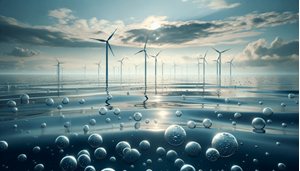News
Lhyfe, Flexens and Stockholm University present the BOxHy project
The Baltic Sea Oxygenation and the Super-Green H2 Economy project, also known as “BOxHy”, is a collaborative effort between Flexens, a strong regional developer of H2 projects, Lhyfe, one of the world’s pioneers in green and renewable H2 production for mobility and industry, and Stockholm University’s Department of Ecology, Environment and Plant Sciences (DEEP).
The main objective of the project is to tackle the problem of “anoxia” (the complete lack of oxygen in the marine environment) in the Baltic Sea by injecting oxygen into the sea via adapted, existing technology. The project will evaluate suitable coastal locations for conducting a pilot study and investigate sector coupling opportunities with green H2 production. The project, led by Flexens, commenced in October 2023 and is expected to conclude in October 2024. The Baltic Sea Action Plan (BSAP) Fund is funding the project.
Injecting pure oxygen below the pycnocline could, in conjunction with external nutrient input limitation, eliminate anoxia in the Baltic Sea. In the BSAP-funded study published in Oct 2022, Vahanen and Jacobs investigated the concept. To continue the work, the BOxHy project will initiate the pilot site preparation for testing oxygen injection in the Baltic Sea.
Deep oxygen injection (DOI) is a method where pure oxygen gas is released deep under the water’s surface, below a region where strong changes in water density occur, using a system that spreads out the oxygen evenly with micro-bubbles. This type of system is already used in several freshwater lakes in the U.S. The project will identify a suitable fjord-scale pilot site for DOI and begin its preparations, including stakeholder engagement and identifying potential funding sources.
“Restoring the oxygen conditions of the Baltic Sea deep water by long-term oxygen additions would have many positive effects on the Baltic Sea ecosystem,” said Jakob Walve, marine ecologist at DEEP, Stockholm University. “The habitat for cod reproduction and feeding would greatly expand. We can also expect lowered phosphorus concentrations as more will be bound in sediments, and thus less intense bloom of nitrogen-fixing, toxic cyanobacteria.”
Revitalizing the Baltic Sea: Linking green H2 production to marine health. The estimated oxygen demand below the pycnocline in the Baltic Sea Proper and Gulf of Finland is 10,000 tpd to ~15,000 tpd. BOxHy proposes a symbiotic approach to Baltic Sea restoration by integrating it with the growing sector of green H2 production. The strategy involves utilizing the oxygen co-produced during water electrolysis—a process of producing H2—to rejuvenate marine ecosystems. This “super-green” H2 production can be vital for financing Baltic Sea Oxygenation.
“Given Flexens’ island roots and passion for the Baltic Sea, we are particularly thrilled to be managing and coordinating this project. Our role includes mapping existing and potential Power-to-X projects to find connections with anoxic regions and determining the electrolyzer capacity required to meet the oxygen demand in these regions. We are also responsible for investigating the energy supply availability for potential large-scale electrolysers from planned offshore wind farms (e.g., in the Åland Islands),” said project manager Szilvia Haide from Flexens.
“The project aims to not only explore the expansion of the ‘super-green’ H2 economy but also to ignite vital discussions on this topic. We’re actively engaging with key stakeholders to navigate the technical, financial, political, regulatory, and social landscapes essential for the success of this innovative initiative. We will also organize informational events and oversee the creation and publication of a project report,” continued Haide.
The project is executed by a team of experts that bring their diverse range of knowledge to the table. French energy company, Lhyfe, has already piloted the world’s first offshore green H2 production facility via the Sealhyfe project of Le Croisic, France. As part of the BOxHy project, Lhyfe will investigate the integration of DOI technology with the offshore H2 production platform, and the replicability of the platform in the Baltic Sea environment.


